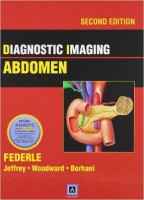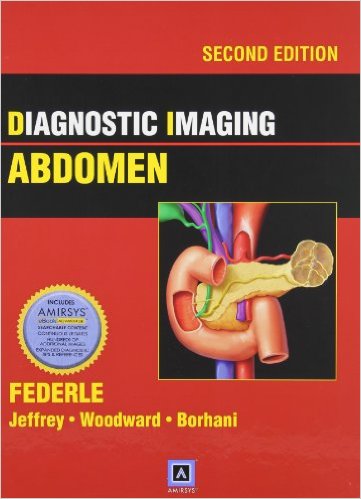 Authors: Michael P. Federle, MD; R. Brooke Jeffrey, MD; Paula J. Woodward, MD; and Amir A. Borhani MD
Authors: Michael P. Federle, MD; R. Brooke Jeffrey, MD; Paula J. Woodward, MD; and Amir A. Borhani MD
Publisher: Amirsys | Lippincott, Williams & Wilkins – 1,288 pages
Book Review by: Nano Khilnani
This thick textbook is unusual from most other medical books because all of the content is presented in bullet-point format, which has proven to be a popular one among time-constrained residents, fellows and established practitioners.
But the lead author Dr. Michael Federle points out that from the comments they received from purchasers of the first edition which was also in bulleted form, many of them preferred to read the introduction to each section in “a more informal prose style.” The reason for this? Dr. Federle writes it is “to grasp the essential anatomical issues, imaging protocols, and general approaches to the most common or important diseases affecting that organ system.”
You will find, in numerous chapters, coverage of innumerable abnormalities, conditions, disorders, diseases, and problems in this massive book of more than 1200 pages. In order not to make this book review too long, we present to you below the book’s four Parts and 18 Sections in a sort of paragraph form.
You can get to the details discussed in each chapter by going to the title in the section that is closest to what you’re looking for. For example if you want to check on the topic intestinal lymphangiectasia, and you do not see that in the list below, you can go to the Section 5 – Small Intestine – in Part II, then turn to the page which has the heading Metabolic or Inherited.
So we present to you below the Parts, Sections, and the types of conditions, disorders, and diseases within each Section:
- Abdominal Manifestations of Systemic Conditions
- Disorders and Conditions: Congenital, Infection, Metabolic or Inherited, Degenerative, Vascular Disorders, Trauma, Transplantation, Malignant Neoplasms, Miscellaneous
- GI Tract and Abdominal Cavity
- Peritoneum, Mesentery and Abdominal Wall: Infection, Inflammation, Degenerative, External Hernias, Internal Hernias, Vascular Disorders, Trauma, Treatment Related, Benign Neoplasms, Malignant Neoplasms, Miscellaneous
- Esophagus: Introduction and Overview, Infection, Inflammation, Degenerative, Vascular Disorders, Esophageal Diverticula, Trauma, Treatment Related, Benign Neoplasms, Malignant Neoplasms
- Stomach: Introduction and Overview, Congenital, Inflammation, Degenerative, Treatment Related, Benign Neoplasms, Malignant Neoplasms
- Duodenum: Introduction and Overview, Normal Variants and Artifcats, Congenital, Inflammation, Vascular Disorders, Trauma, Treatment Related, Benign Neoplasms, Malignant Neoplasms
- Small Intestine: Introduction and Overview, Congenital, Infection, Inflammation, Metabolic or Inherited, Degenerative , Vascular Disorders, Trauma, Treatment Related, Transplantation, Benign Neoplasms, Malignant Neoplasms
- Colon: Introduction and Overview, Infection, Inflammation and Ischemia, Degenerative, Trauma, Benign Neoplasms, Malignant Neoplasms
- Spleen: Introduction and Overview, Normal Variants and Artifacts, Congenital, Infection, Degenerative, Vascular Disorder, Trauma, Benign Neoplasms, Malignant Neoplasms
- Part III Hepatobiliary and Pancreas
- Liver: Introduction and Overview, Congenital, Infection, Inflammation, Metabolic or Inherited, Degenerative, Vascular Disorder, Trauma, Treatment Related, Transplantation, Benign Neoplasms, Malignant Neoplasm
- Biliary System: Introduction and Overview, Normal Variants and Artifcats, Congenital, Infection, Introduction and Overview, Congenital
- Pancreas: Introduction and Overview, Congenital, Infection, Inflammation, Degenerative, Trauma, Transplantation, Benign Neoplasms, Malignant Neoplasms
- Part IV Genitourinary and Retroperitoneum
- Retroperitoneum: Introduction and Overview, Congenital, Inflammation, Degenerative, Treatment Related, Benign Neoplasms, Malignant Neoplasms
- Adrenal: Introduction and Overview, Infection, Metabolic or Inherited, Trauma, Benign Neoplasms, Malignant Neoplasms
- Kidney and Renal Pelvis: Introduction and Overview, Normal Variants and Pseudolesions, Congenital, Infection, Inflammation, Metabolic or Inherited, Degenerative, Vascular Disorders, Trauma, Treatment Related, Transplantation, Benign Neoplasms, Malignant Neoplasms
- Ureter: Introduction and Overview, Congenital, Inflammation, Trauma, Benign Neoplasms, Malignant Neoplasms, Miscellaneous
- Bladder: Introduction and Overview, Congenital, Infection, Degenerative, Trauma, Treatment Related, Benign Neoplasms, Malignant Neoplasms
- Urethra: Introduction and Overview, Infection, Trauma, Malignant
- Neoplasms
- Genital Tract (Male): Introduction and Overview, Testes, Scrotum, Epididymus, Prostate
You can access the contents of this print book online! To access your Amirsys eBook Advantage:
1) Scratch off the silver coating on the inside front cover of this book to reveal the license key
2) Go to http://amirsys.com online
3) Register your title with this license key
This website is for individual use only. For additional details, please read the License Agreement available on the registration page. For technical assistance, please contact ebooks@amirsys.com
Amirsys eBook Advantage Features:
- Searchable content
- Hundreds of additional images
- Continuous updates
- Expanded diagnostic tips and references
You will be pleased to note that each of the chapters follows this basic outline.
The Key Facts are in a box at the beginning of each chapter. And all the chapters have the following headings:
- Terminology
- Imaging
- Top Differential Diagnoses
- Pathology
- Clinical Issues
Each of the above headings is then outlined in bullet-point form with more detail, and images with captions are interspersed among them. In addition to the above headings, two other headings are provided to you with details:
- Diagnostic Checklist
- Selected References
Let’s take a look at the chapter entitled Congenital in Section 1 of Part I. Within that chapter you will find three diseases outlined: tuberous sclerosis, von Hippel-Lindau Disease, and neurofibromatosis, known in short as NFI.
As you read in the Key Facts box, you learn that is an inherited (congenital) disorder characterized by tumors or tumor-like nodule in the central nervous system (CNS). Four computed tomography (CT) are provided with detailed captions.
In the Terminology heading, you will find under the Abbreviations subheading: NFI 1 for neurofibromatosis 1; peripheral neurofibromatosis and von Recklinghausen syndrome under the Synonyms subheading; and under Definitions subheading: “Genetic disorder characterized by development of multiple tumors, predominantly of neuroectodermal pr mesenchymal origin.
The Imaging heading provides numerous bullet-pointed details under the subheadings General Features, Radiographic Findings, MR Findings, and Imaging Recommendations.
The Pathology heading gives you details under the General Features subheading, as well as instructions and guidance under these two subheadings: Staging, Grading & Classification and Gross Pathological & Surgical Features.
Under the Clinical Issues heading you will find a lot of useful information under the subheadings Presentation, Demographics, and Natural History & Prognosis.
Be sure to also check out the information within the Diagnostic Checklist and the list of materials under Selected References.
This book is an indispensable guide and a must-have reference and consultation source. It is like a condensed encyclopedia on the abdomen. Presentation of facts and illustrations is simply superb.
Authors:
Michael P. Federle, MD, FACR is Professor and Associate Chair for Education in the Department of Radiology at Stanford University School of Medicine in Stanford, California.
R. Brooke Jeffrey, MD is Professor and Vice Chairman, and Chief of Abdominal Imaging in the Department of Radiology at Stanford University School of Medicine in Stanford, California.
Paula J. Woodward, MD is David G. Bragg, MD and Marcia R Bragg Presidential Endowed Chair in Oncologic Imaging ; and Professor of Imaging at the University of Utah School of Medicine in Salt Lake City, Utah.
Amir A. Borhani MD is Radiology Resident at the University of Pittsburgh Medical Center in Pittsburgh, Pennsylvania.







